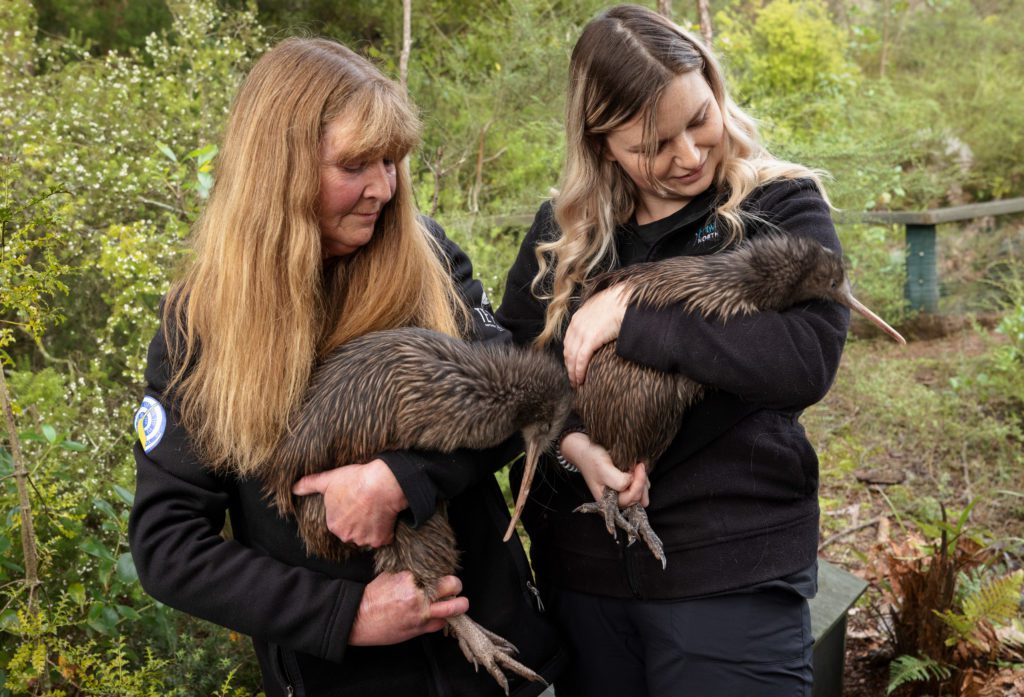Te Puia welcomed a second breeding pair of North Island brown kiwi to its breeding enclosure, bringing the total number of kiwi on-site to seven.
The new pair – Raukura and Zephyr – arrived on Friday 21st May from Kiwi North in Whangarei, and will join Kahu and Awhi, another recently established breeding pair.
Te Puia Kiwi Conservation Centre Manager, Tracy Johnson, says they are delighted to welcome Raukura and Zephyr.
“It’s fantastic to have the pair here with us, demonstrating our clear commitment towards helping to save this precious taonga, one of Aotearoa’s most loved and vulnerable native species,” she says.
Te Puia is one of 14 parks and zoos around Aotearoa that are part of the coordinated captive management programme for the North Island brown kiwi that is overseen by the Department of Conservation (DOC) and the Zoo and Aquarium Association (Australasia).
“Having two breeding pairs means we can take a more active role in the programme and contribute to bolstering the kiwi population in New Zealand,” says Tracy.
“With two pairs, we could potentially have three eggs laid each year per pair, which, if successfully hatched, will either be released into predator safe areas or given to parks and zoos where they will in turn be part of the breeding programme.”
Te Puia’s state-of-the-art Kiwi Conservation Centre opened at the end of 2019, offering manuhiri (visitors) an up-close-and-personal viewing and educational experience.
Tracy says the facility has a focus on preservation and education.
“We have a purpose-built education room with a viewing window into the hospital and food preparation area, giving manuhiri a unique insight into the bird’s monthly health checks.”
The Te Puia team also conduct several presentations throughout the day, showcasing the many aspects of kiwi conservation and the work that Te Puia is involved in, including research projects with DOC, captive breeding, and dog aversion training.
“Manuhiri won’t be able to view the recent arrivals in the breeding enclosure but if they visit Te Puia at night, they’ll likely hear the kiwi calls echoing across the valley. It’s the perfect time to join our Geyser by Night experience, which was established post-COVID to re-connect with New Zealanders,” says Tracy.
Several Te Puia staff that were made redundant when COVID-19 struck, have been re-employed in different roles across the site. This includes experienced guide Miriata Ruaporo who is now working in the conservation team – and thriving.
“Miriata is absolutely flourishing in her new role,” says Tracy. “She’s received extensive training and mentoring and is now undertaking study to gain her captive animal management qualification.”
Te Puia has been home to kiwi since the early 1970s, initially as a rehabilitation centre for injured kiwi that were received from the wild. The original nocturnal house was built in 1976.
Te Puia CEO, Tim Cossar, says the local tourism industry – like much of the world – has navigated many challenges related to COVID-19, and Te Puia has been no exception, however they’ve learnt a lot from the disruption.
“The downtime has been used to reimagine our business. An important outtake has been understanding that our relevance to New Zealanders must be embedded into everything that we do,” he says.
He says this aspiration has helped them build the immersive experiences you’ll see today at Te Puia.
“We look forward to welcoming manuhiri to visit our kiwi, to experience our manaakitangi (hospitality) and embrace the uniqueness that is Aotearoa.”

